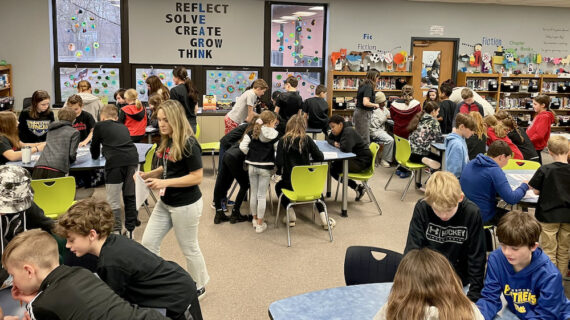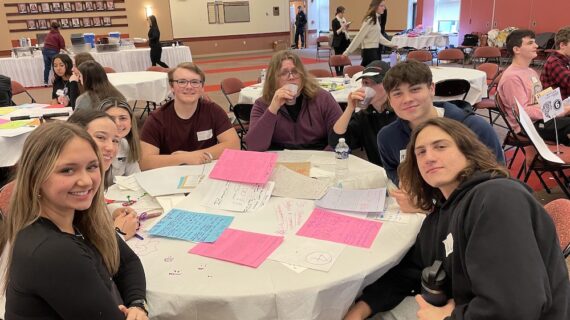
Purchase Line students are taking to the skies — and falling in love with STEM learning in the process
This story is one in a series created in collaboration with the AASA Learning 2025 Alliance to celebrate the work of groundbreaking school districts in the Pittsburgh region. Kidsburgh will share these stories throughout 2024.
Charles Edwards and John Elick had a smooth take-off from Jimmy Stewart Airport. They were comfortably piloting their aircraft above the rolling farmlands of Pennsylvania’s Indiana County when things suddenly turned dire.
“There were alarms going off everywhere,” Edwards remembers. “We were just losing altitude by the second.”
He and Elick desperately sought a solution, but it was too late: “Before we knew it, we were into the ground.”
Fortunately, this hair-raising moment happened inside a flight simulator in a classroom at Purchase Line High School, which serves parts of Indiana and Clearfield counties. Edwards and Elick are students in an innovative aviation and drone-technology class that has inspired them both to consider careers in aeronautics.
The hands-on learning they’re experiencing isn’t just exciting. It’s helping them discover a love of math and science as they begin grasping the complex interplay of nature and technology that keeps planes and drones aloft.
After their first crash in the simulator, Elick says, “we learned to adjust.”
Teacher Andrew Sleppy “taught us how to adjust the flaps and how to adjust our angle of attack to better differentiate when there’s air density problems or temperature problems,” he says. “So we learned how we were able to do that and able to keep in flight.”

SCIENCE KNOWLEDGE AND HANDS-ON SKILLS
Through a curriculum designed by the Aircraft Owners and Pilots Association, Sleppy’s 21 students began the year discussing aircraft components and the science that allows them to fly.
Their classroom at Purchase Line is one of a very few in western Pennsylvania to be outfitted with flight simulators and drones, along with a drone obstacle course. Suffice it to say that this kind of offering is hardly standard at most high schools.
Though this introductory-level course focuses mainly on science and theory, the simulators give students a chance to put their learning into practice .
Flying in the simulator is “pretty realistic,” Edwards says. ”It’s got every control and it’s very in depth.”
Jessica Lindsay, the district’s director of curriculum and innovation, had heard about the curriculum and mentioned it to Sleppy last year. She knew he was interested in expanding the school’s science and technology offerings — something Purchase Line has prioritized.
The district is part of the Western Pennsylvania Learning 2025 Alliance, a regional cohort of school districts working together — with support from The Grable Foundation — to create student-centered, equity-focused, future-driven schools. Led by local superintendents and AASA, The School Superintendents Association, the Alliance convenes to help districts like Purchase Line innovate in ways that will prepare their students for success in our rapidly changing world.
“With us being such a small school, it’s a rare course to be offered,” Edwards says. “It’s sparking a lot of kids’ interest as far as getting into the industry.”

DISCOVERING NEW CAREER PATHS
Many students at Purchase Line hadn’t seen drones in person before enrolling in aviation class. Now, they’re fascinated — and looking ahead to eventually taking the exam to earn a federal drone pilot license. Other students are looking into booking actual test flights that are offered to students at Jimmy Stewart Airport, now that they’ve virtually taken off from the nearby airport through the simulator.
That’s the dividend that an approach like this can pay — direct and measurable involvement by students in something exciting and enriching.
Another next step available to Purchase Line’s aviation students: A local chapter of Young Eagles, which is a civil air patrol organization for young people.
There are so many potential career paths related to aviation, Sleppy says: “I tell them every day that the aviation sector needs people — not just pilots but flight attendants, engineers, even designers.”
But even if they don’t pursue aviation professionally, Sleppy finds real value in this uncommon class.
“I’m a math teacher by trade. I like math and I like formulas. Part of that air density lesson is lots of math, and of course the kids think, ‘Why do we always have to do this stuff?’ But as soon as I had them on the simulator,” he says, “and I had them change the temperature and the air pressure, they were like, ‘Why is this airplane taking a long time to get off the ground?’”
That, he says, is when the “aha” moment arrived: “They were like, ‘Oh, wait a second. This math and science stuff does work!’”
Want to download this story? Click here for a PDF.













